Business Environment Analysis and Strategic Recommendations for Oxfam
VerifiedAdded on 2022/09/21
|7
|2084
|22
Report
AI Summary
This report provides a comprehensive analysis of Oxfam's business environment, examining both internal and external factors. The analysis utilizes PESTLE and SWOT frameworks to evaluate the organization's strategic position and identify key influences. The PESTLE analysis delves into political, economic, social, technological, legal, and environmental factors impacting Oxfam's operations. The SWOT analysis assesses Oxfam's strengths, weaknesses, opportunities, and threats, highlighting its brand reputation, financial transparency, and global reach, while also acknowledging vulnerabilities related to ethical concerns and reliance on donations. The report further explores the impact of these findings on Oxfam's decision-making processes and strategic planning, emphasizing the interconnectedness of internal and external factors. The conclusion emphasizes how Oxfam can leverage its strengths and opportunities to maximize its impact and successfully manage its external environment.
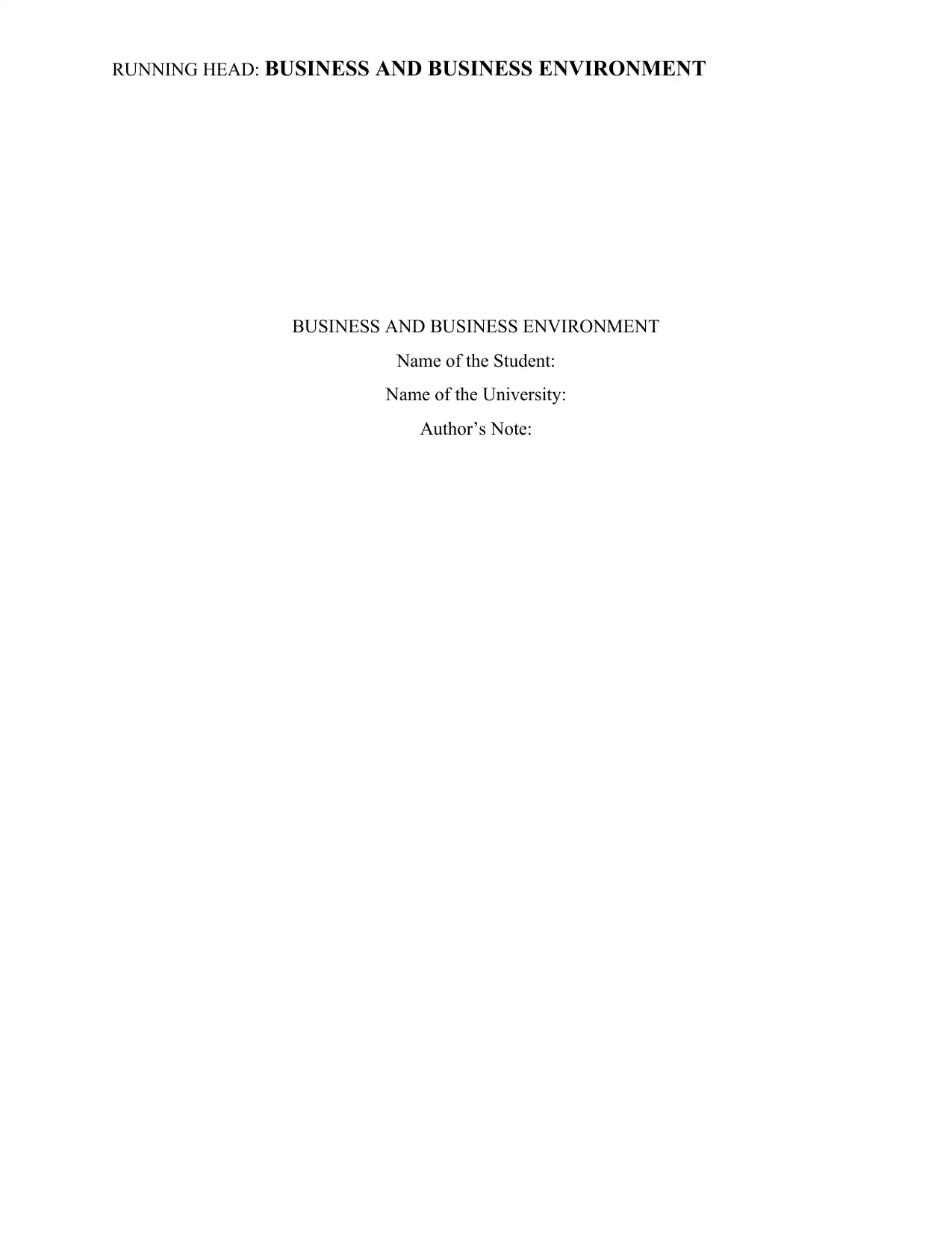
RUNNING HEAD: BUSINESS AND BUSINESS ENVIRONMENT
BUSINESS AND BUSINESS ENVIRONMENT
Name of the Student:
Name of the University:
Author’s Note:
BUSINESS AND BUSINESS ENVIRONMENT
Name of the Student:
Name of the University:
Author’s Note:
Paraphrase This Document
Need a fresh take? Get an instant paraphrase of this document with our AI Paraphraser
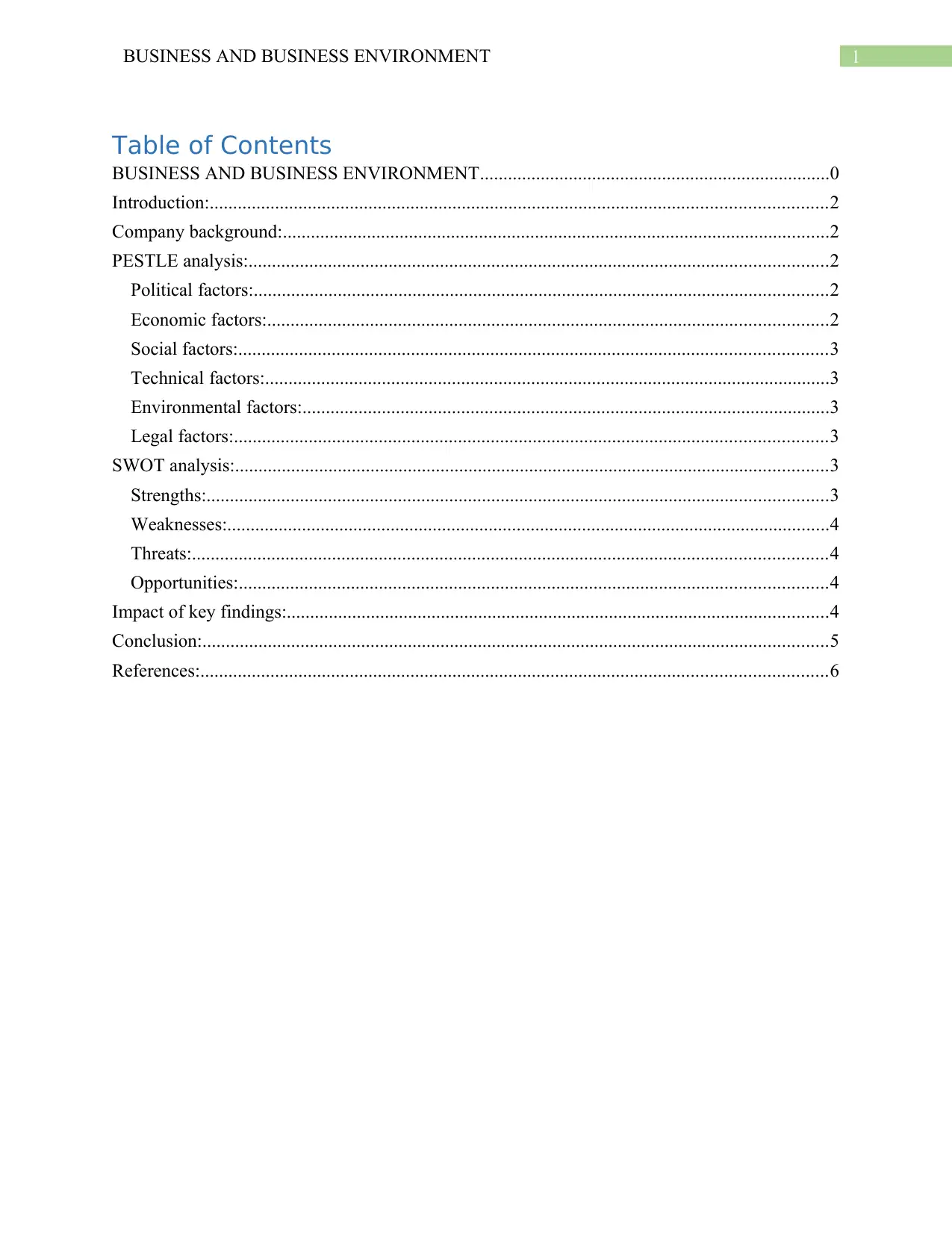
1BUSINESS AND BUSINESS ENVIRONMENT
Table of Contents
BUSINESS AND BUSINESS ENVIRONMENT...........................................................................0
Introduction:....................................................................................................................................2
Company background:.....................................................................................................................2
PESTLE analysis:............................................................................................................................2
Political factors:...........................................................................................................................2
Economic factors:........................................................................................................................2
Social factors:..............................................................................................................................3
Technical factors:.........................................................................................................................3
Environmental factors:.................................................................................................................3
Legal factors:...............................................................................................................................3
SWOT analysis:...............................................................................................................................3
Strengths:.....................................................................................................................................3
Weaknesses:.................................................................................................................................4
Threats:........................................................................................................................................4
Opportunities:..............................................................................................................................4
Impact of key findings:....................................................................................................................4
Conclusion:......................................................................................................................................5
References:......................................................................................................................................6
Table of Contents
BUSINESS AND BUSINESS ENVIRONMENT...........................................................................0
Introduction:....................................................................................................................................2
Company background:.....................................................................................................................2
PESTLE analysis:............................................................................................................................2
Political factors:...........................................................................................................................2
Economic factors:........................................................................................................................2
Social factors:..............................................................................................................................3
Technical factors:.........................................................................................................................3
Environmental factors:.................................................................................................................3
Legal factors:...............................................................................................................................3
SWOT analysis:...............................................................................................................................3
Strengths:.....................................................................................................................................3
Weaknesses:.................................................................................................................................4
Threats:........................................................................................................................................4
Opportunities:..............................................................................................................................4
Impact of key findings:....................................................................................................................4
Conclusion:......................................................................................................................................5
References:......................................................................................................................................6
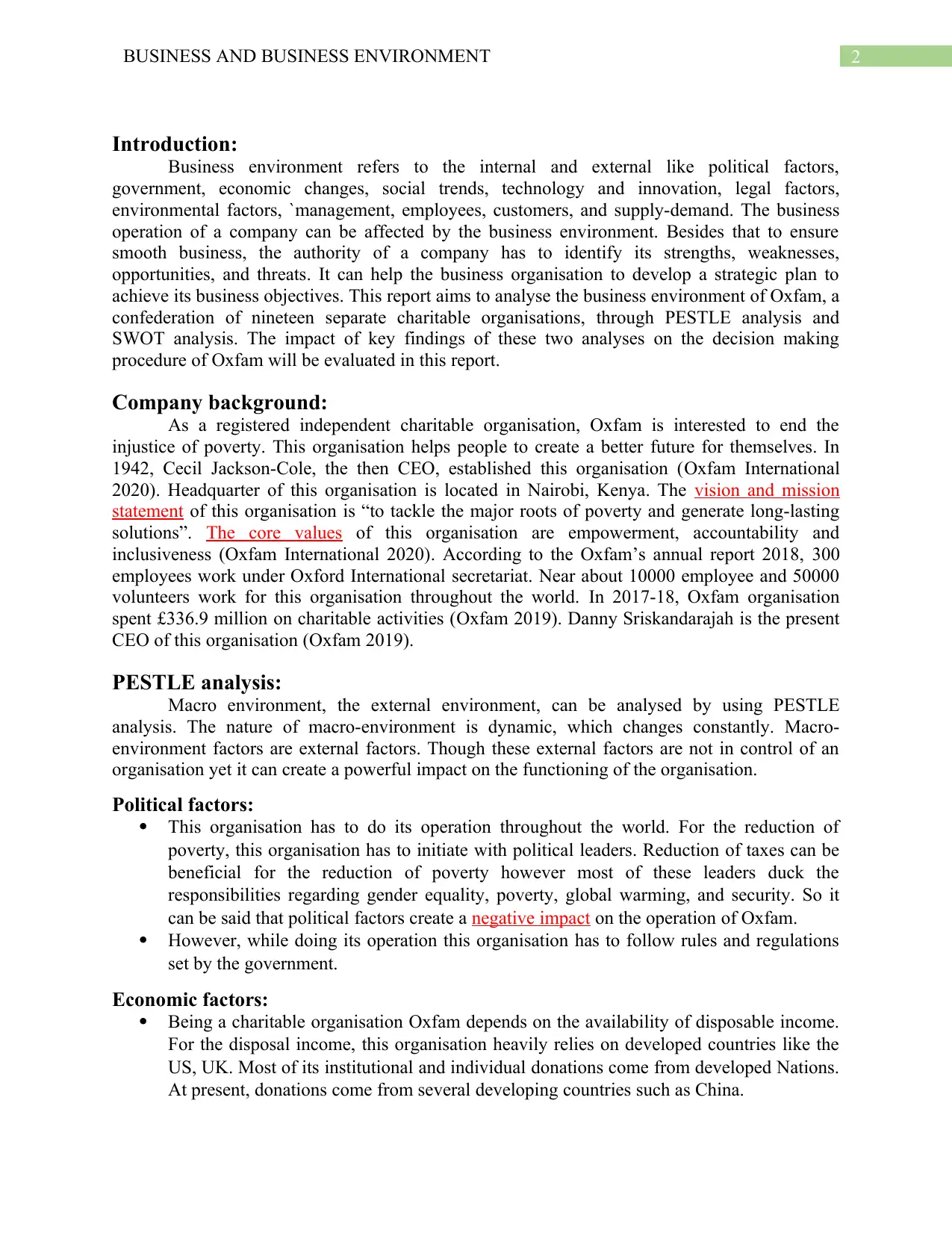
2BUSINESS AND BUSINESS ENVIRONMENT
Introduction:
Business environment refers to the internal and external like political factors,
government, economic changes, social trends, technology and innovation, legal factors,
environmental factors, `management, employees, customers, and supply-demand. The business
operation of a company can be affected by the business environment. Besides that to ensure
smooth business, the authority of a company has to identify its strengths, weaknesses,
opportunities, and threats. It can help the business organisation to develop a strategic plan to
achieve its business objectives. This report aims to analyse the business environment of Oxfam, a
confederation of nineteen separate charitable organisations, through PESTLE analysis and
SWOT analysis. The impact of key findings of these two analyses on the decision making
procedure of Oxfam will be evaluated in this report.
Company background:
As a registered independent charitable organisation, Oxfam is interested to end the
injustice of poverty. This organisation helps people to create a better future for themselves. In
1942, Cecil Jackson-Cole, the then CEO, established this organisation (Oxfam International
2020). Headquarter of this organisation is located in Nairobi, Kenya. The vision and mission
statement of this organisation is “to tackle the major roots of poverty and generate long-lasting
solutions”. The core values of this organisation are empowerment, accountability and
inclusiveness (Oxfam International 2020). According to the Oxfam’s annual report 2018, 300
employees work under Oxford International secretariat. Near about 10000 employee and 50000
volunteers work for this organisation throughout the world. In 2017-18, Oxfam organisation
spent £336.9 million on charitable activities (Oxfam 2019). Danny Sriskandarajah is the present
CEO of this organisation (Oxfam 2019).
PESTLE analysis:
Macro environment, the external environment, can be analysed by using PESTLE
analysis. The nature of macro-environment is dynamic, which changes constantly. Macro-
environment factors are external factors. Though these external factors are not in control of an
organisation yet it can create a powerful impact on the functioning of the organisation.
Political factors:
This organisation has to do its operation throughout the world. For the reduction of
poverty, this organisation has to initiate with political leaders. Reduction of taxes can be
beneficial for the reduction of poverty however most of these leaders duck the
responsibilities regarding gender equality, poverty, global warming, and security. So it
can be said that political factors create a negative impact on the operation of Oxfam.
However, while doing its operation this organisation has to follow rules and regulations
set by the government.
Economic factors:
Being a charitable organisation Oxfam depends on the availability of disposable income.
For the disposal income, this organisation heavily relies on developed countries like the
US, UK. Most of its institutional and individual donations come from developed Nations.
At present, donations come from several developing countries such as China.
Introduction:
Business environment refers to the internal and external like political factors,
government, economic changes, social trends, technology and innovation, legal factors,
environmental factors, `management, employees, customers, and supply-demand. The business
operation of a company can be affected by the business environment. Besides that to ensure
smooth business, the authority of a company has to identify its strengths, weaknesses,
opportunities, and threats. It can help the business organisation to develop a strategic plan to
achieve its business objectives. This report aims to analyse the business environment of Oxfam, a
confederation of nineteen separate charitable organisations, through PESTLE analysis and
SWOT analysis. The impact of key findings of these two analyses on the decision making
procedure of Oxfam will be evaluated in this report.
Company background:
As a registered independent charitable organisation, Oxfam is interested to end the
injustice of poverty. This organisation helps people to create a better future for themselves. In
1942, Cecil Jackson-Cole, the then CEO, established this organisation (Oxfam International
2020). Headquarter of this organisation is located in Nairobi, Kenya. The vision and mission
statement of this organisation is “to tackle the major roots of poverty and generate long-lasting
solutions”. The core values of this organisation are empowerment, accountability and
inclusiveness (Oxfam International 2020). According to the Oxfam’s annual report 2018, 300
employees work under Oxford International secretariat. Near about 10000 employee and 50000
volunteers work for this organisation throughout the world. In 2017-18, Oxfam organisation
spent £336.9 million on charitable activities (Oxfam 2019). Danny Sriskandarajah is the present
CEO of this organisation (Oxfam 2019).
PESTLE analysis:
Macro environment, the external environment, can be analysed by using PESTLE
analysis. The nature of macro-environment is dynamic, which changes constantly. Macro-
environment factors are external factors. Though these external factors are not in control of an
organisation yet it can create a powerful impact on the functioning of the organisation.
Political factors:
This organisation has to do its operation throughout the world. For the reduction of
poverty, this organisation has to initiate with political leaders. Reduction of taxes can be
beneficial for the reduction of poverty however most of these leaders duck the
responsibilities regarding gender equality, poverty, global warming, and security. So it
can be said that political factors create a negative impact on the operation of Oxfam.
However, while doing its operation this organisation has to follow rules and regulations
set by the government.
Economic factors:
Being a charitable organisation Oxfam depends on the availability of disposable income.
For the disposal income, this organisation heavily relies on developed countries like the
US, UK. Most of its institutional and individual donations come from developed Nations.
At present, donations come from several developing countries such as China.
⊘ This is a preview!⊘
Do you want full access?
Subscribe today to unlock all pages.

Trusted by 1+ million students worldwide
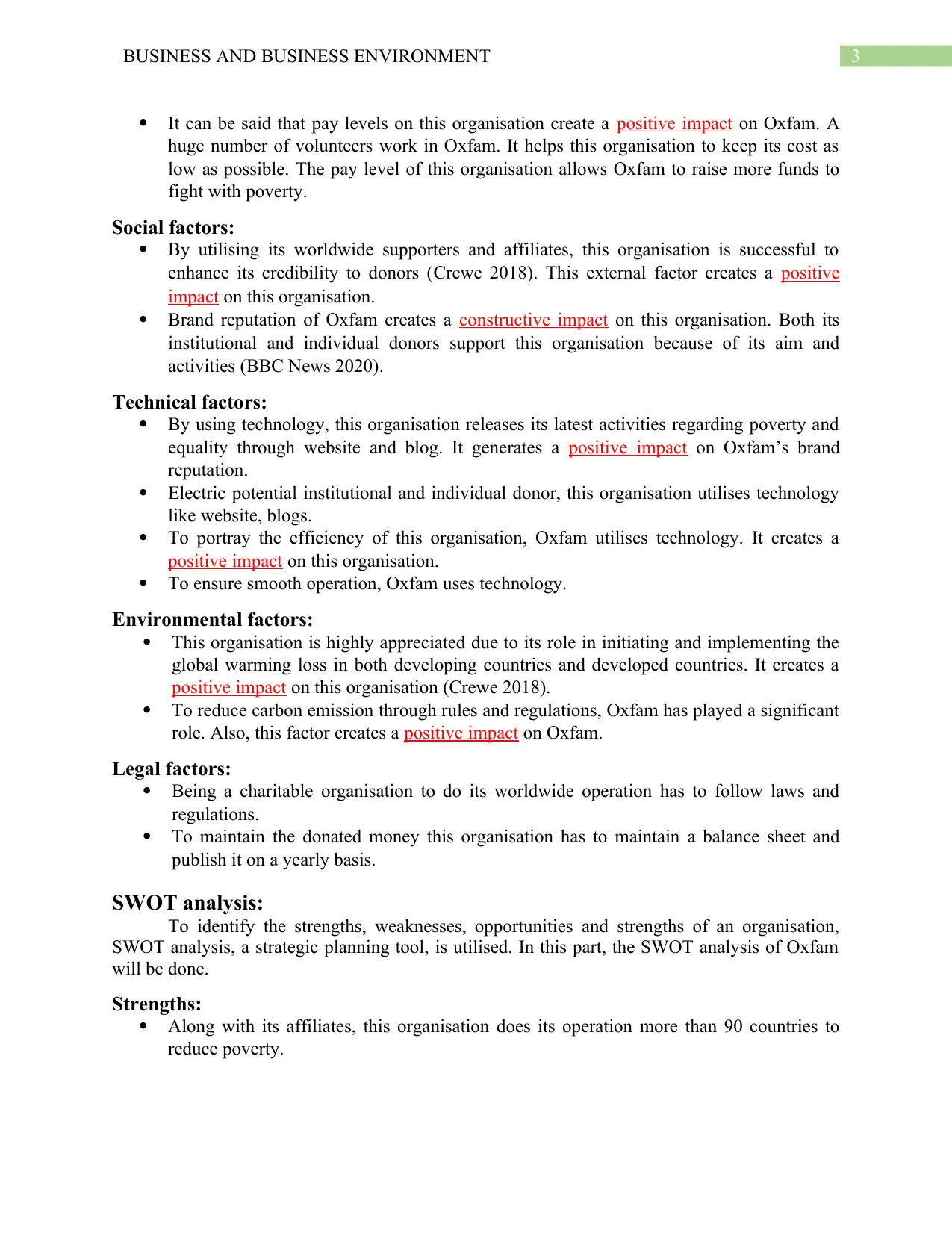
3BUSINESS AND BUSINESS ENVIRONMENT
It can be said that pay levels on this organisation create a positive impact on Oxfam. A
huge number of volunteers work in Oxfam. It helps this organisation to keep its cost as
low as possible. The pay level of this organisation allows Oxfam to raise more funds to
fight with poverty.
Social factors:
By utilising its worldwide supporters and affiliates, this organisation is successful to
enhance its credibility to donors (Crewe 2018). This external factor creates a positive
impact on this organisation.
Brand reputation of Oxfam creates a constructive impact on this organisation. Both its
institutional and individual donors support this organisation because of its aim and
activities (BBC News 2020).
Technical factors:
By using technology, this organisation releases its latest activities regarding poverty and
equality through website and blog. It generates a positive impact on Oxfam’s brand
reputation.
Electric potential institutional and individual donor, this organisation utilises technology
like website, blogs.
To portray the efficiency of this organisation, Oxfam utilises technology. It creates a
positive impact on this organisation.
To ensure smooth operation, Oxfam uses technology.
Environmental factors:
This organisation is highly appreciated due to its role in initiating and implementing the
global warming loss in both developing countries and developed countries. It creates a
positive impact on this organisation (Crewe 2018).
To reduce carbon emission through rules and regulations, Oxfam has played a significant
role. Also, this factor creates a positive impact on Oxfam.
Legal factors:
Being a charitable organisation to do its worldwide operation has to follow laws and
regulations.
To maintain the donated money this organisation has to maintain a balance sheet and
publish it on a yearly basis.
SWOT analysis:
To identify the strengths, weaknesses, opportunities and strengths of an organisation,
SWOT analysis, a strategic planning tool, is utilised. In this part, the SWOT analysis of Oxfam
will be done.
Strengths:
Along with its affiliates, this organisation does its operation more than 90 countries to
reduce poverty.
It can be said that pay levels on this organisation create a positive impact on Oxfam. A
huge number of volunteers work in Oxfam. It helps this organisation to keep its cost as
low as possible. The pay level of this organisation allows Oxfam to raise more funds to
fight with poverty.
Social factors:
By utilising its worldwide supporters and affiliates, this organisation is successful to
enhance its credibility to donors (Crewe 2018). This external factor creates a positive
impact on this organisation.
Brand reputation of Oxfam creates a constructive impact on this organisation. Both its
institutional and individual donors support this organisation because of its aim and
activities (BBC News 2020).
Technical factors:
By using technology, this organisation releases its latest activities regarding poverty and
equality through website and blog. It generates a positive impact on Oxfam’s brand
reputation.
Electric potential institutional and individual donor, this organisation utilises technology
like website, blogs.
To portray the efficiency of this organisation, Oxfam utilises technology. It creates a
positive impact on this organisation.
To ensure smooth operation, Oxfam uses technology.
Environmental factors:
This organisation is highly appreciated due to its role in initiating and implementing the
global warming loss in both developing countries and developed countries. It creates a
positive impact on this organisation (Crewe 2018).
To reduce carbon emission through rules and regulations, Oxfam has played a significant
role. Also, this factor creates a positive impact on Oxfam.
Legal factors:
Being a charitable organisation to do its worldwide operation has to follow laws and
regulations.
To maintain the donated money this organisation has to maintain a balance sheet and
publish it on a yearly basis.
SWOT analysis:
To identify the strengths, weaknesses, opportunities and strengths of an organisation,
SWOT analysis, a strategic planning tool, is utilised. In this part, the SWOT analysis of Oxfam
will be done.
Strengths:
Along with its affiliates, this organisation does its operation more than 90 countries to
reduce poverty.
Paraphrase This Document
Need a fresh take? Get an instant paraphrase of this document with our AI Paraphraser
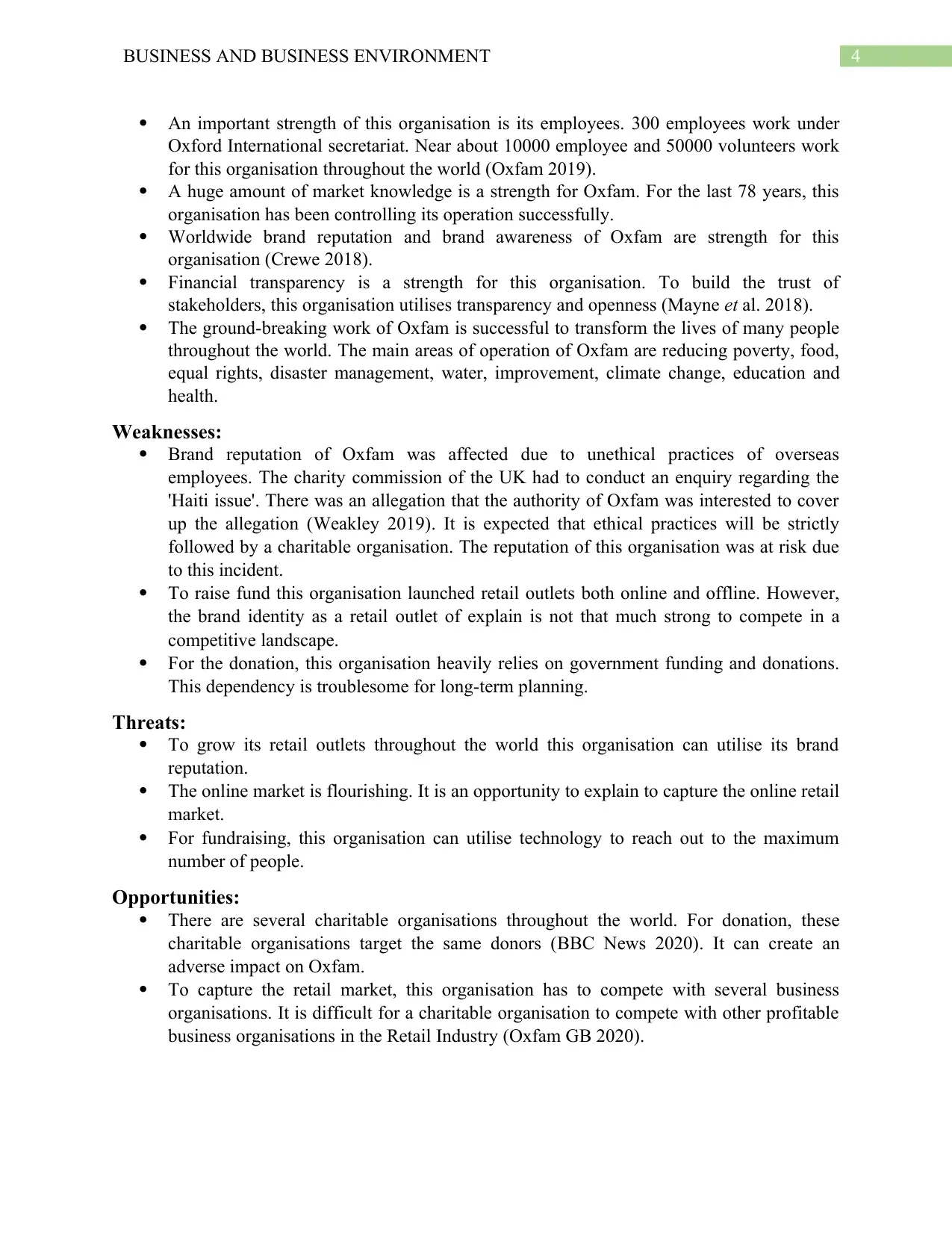
4BUSINESS AND BUSINESS ENVIRONMENT
An important strength of this organisation is its employees. 300 employees work under
Oxford International secretariat. Near about 10000 employee and 50000 volunteers work
for this organisation throughout the world (Oxfam 2019).
A huge amount of market knowledge is a strength for Oxfam. For the last 78 years, this
organisation has been controlling its operation successfully.
Worldwide brand reputation and brand awareness of Oxfam are strength for this
organisation (Crewe 2018).
Financial transparency is a strength for this organisation. To build the trust of
stakeholders, this organisation utilises transparency and openness (Mayne et al. 2018).
The ground-breaking work of Oxfam is successful to transform the lives of many people
throughout the world. The main areas of operation of Oxfam are reducing poverty, food,
equal rights, disaster management, water, improvement, climate change, education and
health.
Weaknesses:
Brand reputation of Oxfam was affected due to unethical practices of overseas
employees. The charity commission of the UK had to conduct an enquiry regarding the
'Haiti issue'. There was an allegation that the authority of Oxfam was interested to cover
up the allegation (Weakley 2019). It is expected that ethical practices will be strictly
followed by a charitable organisation. The reputation of this organisation was at risk due
to this incident.
To raise fund this organisation launched retail outlets both online and offline. However,
the brand identity as a retail outlet of explain is not that much strong to compete in a
competitive landscape.
For the donation, this organisation heavily relies on government funding and donations.
This dependency is troublesome for long-term planning.
Threats:
To grow its retail outlets throughout the world this organisation can utilise its brand
reputation.
The online market is flourishing. It is an opportunity to explain to capture the online retail
market.
For fundraising, this organisation can utilise technology to reach out to the maximum
number of people.
Opportunities:
There are several charitable organisations throughout the world. For donation, these
charitable organisations target the same donors (BBC News 2020). It can create an
adverse impact on Oxfam.
To capture the retail market, this organisation has to compete with several business
organisations. It is difficult for a charitable organisation to compete with other profitable
business organisations in the Retail Industry (Oxfam GB 2020).
An important strength of this organisation is its employees. 300 employees work under
Oxford International secretariat. Near about 10000 employee and 50000 volunteers work
for this organisation throughout the world (Oxfam 2019).
A huge amount of market knowledge is a strength for Oxfam. For the last 78 years, this
organisation has been controlling its operation successfully.
Worldwide brand reputation and brand awareness of Oxfam are strength for this
organisation (Crewe 2018).
Financial transparency is a strength for this organisation. To build the trust of
stakeholders, this organisation utilises transparency and openness (Mayne et al. 2018).
The ground-breaking work of Oxfam is successful to transform the lives of many people
throughout the world. The main areas of operation of Oxfam are reducing poverty, food,
equal rights, disaster management, water, improvement, climate change, education and
health.
Weaknesses:
Brand reputation of Oxfam was affected due to unethical practices of overseas
employees. The charity commission of the UK had to conduct an enquiry regarding the
'Haiti issue'. There was an allegation that the authority of Oxfam was interested to cover
up the allegation (Weakley 2019). It is expected that ethical practices will be strictly
followed by a charitable organisation. The reputation of this organisation was at risk due
to this incident.
To raise fund this organisation launched retail outlets both online and offline. However,
the brand identity as a retail outlet of explain is not that much strong to compete in a
competitive landscape.
For the donation, this organisation heavily relies on government funding and donations.
This dependency is troublesome for long-term planning.
Threats:
To grow its retail outlets throughout the world this organisation can utilise its brand
reputation.
The online market is flourishing. It is an opportunity to explain to capture the online retail
market.
For fundraising, this organisation can utilise technology to reach out to the maximum
number of people.
Opportunities:
There are several charitable organisations throughout the world. For donation, these
charitable organisations target the same donors (BBC News 2020). It can create an
adverse impact on Oxfam.
To capture the retail market, this organisation has to compete with several business
organisations. It is difficult for a charitable organisation to compete with other profitable
business organisations in the Retail Industry (Oxfam GB 2020).
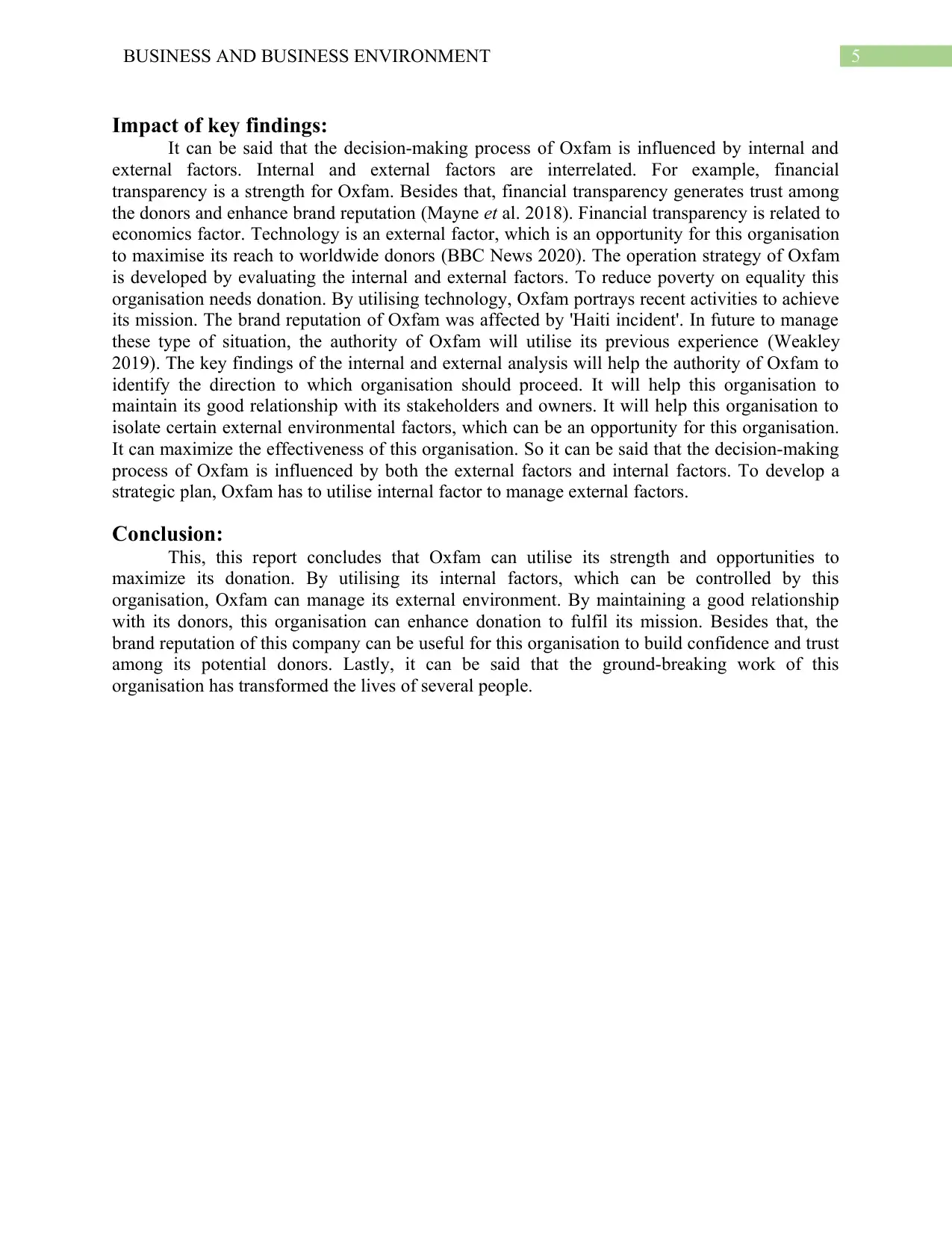
5BUSINESS AND BUSINESS ENVIRONMENT
Impact of key findings:
It can be said that the decision-making process of Oxfam is influenced by internal and
external factors. Internal and external factors are interrelated. For example, financial
transparency is a strength for Oxfam. Besides that, financial transparency generates trust among
the donors and enhance brand reputation (Mayne et al. 2018). Financial transparency is related to
economics factor. Technology is an external factor, which is an opportunity for this organisation
to maximise its reach to worldwide donors (BBC News 2020). The operation strategy of Oxfam
is developed by evaluating the internal and external factors. To reduce poverty on equality this
organisation needs donation. By utilising technology, Oxfam portrays recent activities to achieve
its mission. The brand reputation of Oxfam was affected by 'Haiti incident'. In future to manage
these type of situation, the authority of Oxfam will utilise its previous experience (Weakley
2019). The key findings of the internal and external analysis will help the authority of Oxfam to
identify the direction to which organisation should proceed. It will help this organisation to
maintain its good relationship with its stakeholders and owners. It will help this organisation to
isolate certain external environmental factors, which can be an opportunity for this organisation.
It can maximize the effectiveness of this organisation. So it can be said that the decision-making
process of Oxfam is influenced by both the external factors and internal factors. To develop a
strategic plan, Oxfam has to utilise internal factor to manage external factors.
Conclusion:
This, this report concludes that Oxfam can utilise its strength and opportunities to
maximize its donation. By utilising its internal factors, which can be controlled by this
organisation, Oxfam can manage its external environment. By maintaining a good relationship
with its donors, this organisation can enhance donation to fulfil its mission. Besides that, the
brand reputation of this company can be useful for this organisation to build confidence and trust
among its potential donors. Lastly, it can be said that the ground-breaking work of this
organisation has transformed the lives of several people.
Impact of key findings:
It can be said that the decision-making process of Oxfam is influenced by internal and
external factors. Internal and external factors are interrelated. For example, financial
transparency is a strength for Oxfam. Besides that, financial transparency generates trust among
the donors and enhance brand reputation (Mayne et al. 2018). Financial transparency is related to
economics factor. Technology is an external factor, which is an opportunity for this organisation
to maximise its reach to worldwide donors (BBC News 2020). The operation strategy of Oxfam
is developed by evaluating the internal and external factors. To reduce poverty on equality this
organisation needs donation. By utilising technology, Oxfam portrays recent activities to achieve
its mission. The brand reputation of Oxfam was affected by 'Haiti incident'. In future to manage
these type of situation, the authority of Oxfam will utilise its previous experience (Weakley
2019). The key findings of the internal and external analysis will help the authority of Oxfam to
identify the direction to which organisation should proceed. It will help this organisation to
maintain its good relationship with its stakeholders and owners. It will help this organisation to
isolate certain external environmental factors, which can be an opportunity for this organisation.
It can maximize the effectiveness of this organisation. So it can be said that the decision-making
process of Oxfam is influenced by both the external factors and internal factors. To develop a
strategic plan, Oxfam has to utilise internal factor to manage external factors.
Conclusion:
This, this report concludes that Oxfam can utilise its strength and opportunities to
maximize its donation. By utilising its internal factors, which can be controlled by this
organisation, Oxfam can manage its external environment. By maintaining a good relationship
with its donors, this organisation can enhance donation to fulfil its mission. Besides that, the
brand reputation of this company can be useful for this organisation to build confidence and trust
among its potential donors. Lastly, it can be said that the ground-breaking work of this
organisation has transformed the lives of several people.
⊘ This is a preview!⊘
Do you want full access?
Subscribe today to unlock all pages.

Trusted by 1+ million students worldwide
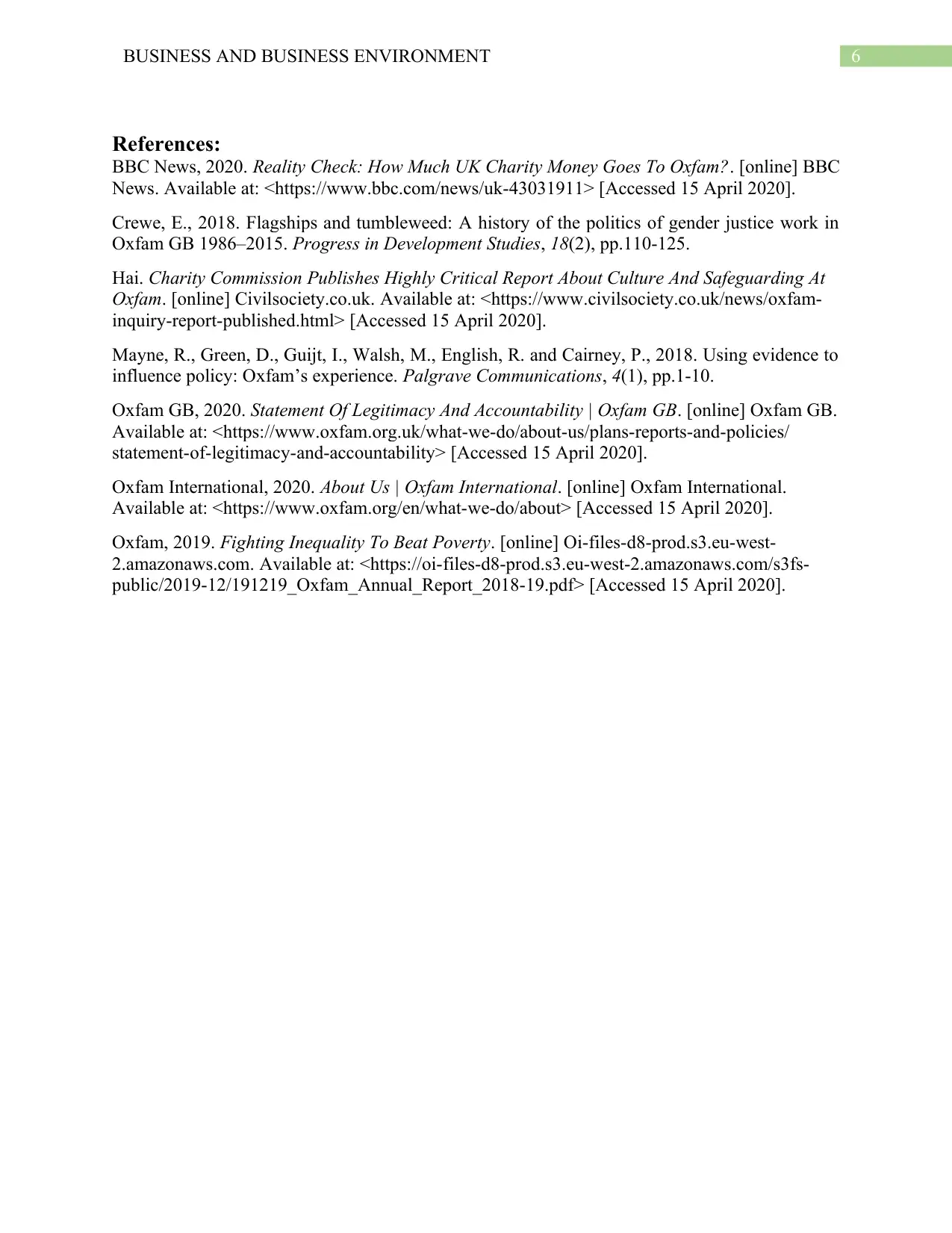
6BUSINESS AND BUSINESS ENVIRONMENT
References:
BBC News, 2020. Reality Check: How Much UK Charity Money Goes To Oxfam?. [online] BBC
News. Available at: <https://www.bbc.com/news/uk-43031911> [Accessed 15 April 2020].
Crewe, E., 2018. Flagships and tumbleweed: A history of the politics of gender justice work in
Oxfam GB 1986–2015. Progress in Development Studies, 18(2), pp.110-125.
Hai. Charity Commission Publishes Highly Critical Report About Culture And Safeguarding At
Oxfam. [online] Civilsociety.co.uk. Available at: <https://www.civilsociety.co.uk/news/oxfam-
inquiry-report-published.html> [Accessed 15 April 2020].
Mayne, R., Green, D., Guijt, I., Walsh, M., English, R. and Cairney, P., 2018. Using evidence to
influence policy: Oxfam’s experience. Palgrave Communications, 4(1), pp.1-10.
Oxfam GB, 2020. Statement Of Legitimacy And Accountability | Oxfam GB. [online] Oxfam GB.
Available at: <https://www.oxfam.org.uk/what-we-do/about-us/plans-reports-and-policies/
statement-of-legitimacy-and-accountability> [Accessed 15 April 2020].
Oxfam International, 2020. About Us | Oxfam International. [online] Oxfam International.
Available at: <https://www.oxfam.org/en/what-we-do/about> [Accessed 15 April 2020].
Oxfam, 2019. Fighting Inequality To Beat Poverty. [online] Oi-files-d8-prod.s3.eu-west-
2.amazonaws.com. Available at: <https://oi-files-d8-prod.s3.eu-west-2.amazonaws.com/s3fs-
public/2019-12/191219_Oxfam_Annual_Report_2018-19.pdf> [Accessed 15 April 2020].
References:
BBC News, 2020. Reality Check: How Much UK Charity Money Goes To Oxfam?. [online] BBC
News. Available at: <https://www.bbc.com/news/uk-43031911> [Accessed 15 April 2020].
Crewe, E., 2018. Flagships and tumbleweed: A history of the politics of gender justice work in
Oxfam GB 1986–2015. Progress in Development Studies, 18(2), pp.110-125.
Hai. Charity Commission Publishes Highly Critical Report About Culture And Safeguarding At
Oxfam. [online] Civilsociety.co.uk. Available at: <https://www.civilsociety.co.uk/news/oxfam-
inquiry-report-published.html> [Accessed 15 April 2020].
Mayne, R., Green, D., Guijt, I., Walsh, M., English, R. and Cairney, P., 2018. Using evidence to
influence policy: Oxfam’s experience. Palgrave Communications, 4(1), pp.1-10.
Oxfam GB, 2020. Statement Of Legitimacy And Accountability | Oxfam GB. [online] Oxfam GB.
Available at: <https://www.oxfam.org.uk/what-we-do/about-us/plans-reports-and-policies/
statement-of-legitimacy-and-accountability> [Accessed 15 April 2020].
Oxfam International, 2020. About Us | Oxfam International. [online] Oxfam International.
Available at: <https://www.oxfam.org/en/what-we-do/about> [Accessed 15 April 2020].
Oxfam, 2019. Fighting Inequality To Beat Poverty. [online] Oi-files-d8-prod.s3.eu-west-
2.amazonaws.com. Available at: <https://oi-files-d8-prod.s3.eu-west-2.amazonaws.com/s3fs-
public/2019-12/191219_Oxfam_Annual_Report_2018-19.pdf> [Accessed 15 April 2020].
1 out of 7
Related Documents
Your All-in-One AI-Powered Toolkit for Academic Success.
+13062052269
info@desklib.com
Available 24*7 on WhatsApp / Email
![[object Object]](/_next/static/media/star-bottom.7253800d.svg)
Unlock your academic potential
Copyright © 2020–2025 A2Z Services. All Rights Reserved. Developed and managed by ZUCOL.



